We teach you the essentials of how to design and print a unique deck of custom trading cards to sell
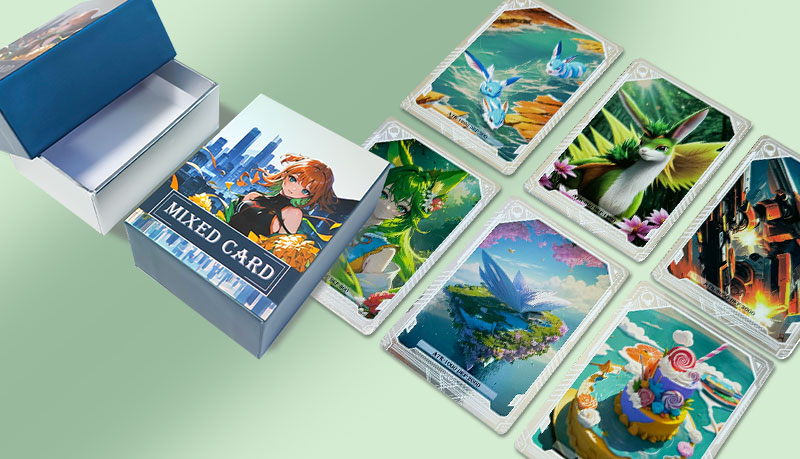
According to the Cornell University Library, the forerunner of the modern trading card games—often attributed to the first publication of Magic: The Gathering in 1993—can actually be found as far back as the 1870s with the rise of the original “trade cards”. In the late 19th century in the USA—as in Britain and across Europe—industrialization was in full swing, bringing increasing wealth and broadening the opportunities for businesses small and large to grow and increase their outreach. It was in this atmosphere of economic growth and increased commercial competition that trade cards arose as a portable and innovative form of advertising. The sturdy, colorful cards proved extremely popular with the public and soon proliferated as enthusiasts started collecting them and swapping them. By the 1900s the begins of rules and systems of exchange based on the number, type and value of the cards had evolved and a nascent “game” of trading cards had begun.
The hobby fell in and out of fashion over the decades, and while the presence of trade cards was a constant—think of the cigarette cards and bubblegum cards with sports themes, historical or famous persons, motor cars and so on as their topics popular from the 50s onward—but the production of the cards declined and interest in collecting and trading them reduced to a “niche” pastime pursued by isolated groups of enthusiasts. Fast-forward to the 1990s and the first publication of Magic: The Gathering.
This extraordinarily simple and yet innovative game became an overnight success and has inspired dozens, if not hundreds, of other games in the genre. But there’s still room for more! Trading cards have grown from a simple hobby for collectors and schoolkids to a serious gaming tradition with clubs, online forums, conventions, and competitions with cash prizes. TCGs – as they are known for short –attract hordes of players of all ages; kids, teenagers, and adults alike. They’ve also become one of the most widespread and continually developing branches of the table top and card game industry. If you are an aspiring game designer in need of unique cards for your project, creating custom trading cards is a fun and rewarding endeavor. As one of the world’s leading international offset printing companies with literally decades of success under our belt, we’ve worked with several mainstream publishers and even more independent creatives to help design and print game cards of excellence. In this no-frills guide, we’ll walk you through the basics you need to get started with the process of how to design and print custom trading cards to a professional level of design and production that means you can sell them.
First, choose a theme
The first step to creating your own custom trading cards is to choose a theme or concept. This is an essential starting point as it will inform the style, artwork, size, number of cards, text, points system and more that you might want to include in your custom trading card deck. A clear theme will give your cards a cohesive and unique identity and give the artist—if it’s not you—solid ideas to work on when making the imagery. When you’re choosing a theme, especially if you want to sell your cards, try to strike a balance between a topic which interests you and something that you think will appeal to others. Brainstorm your interests, hobbies, other games you love, movies, comics, artwork, anything that might give you an idea. Write down everything you can think of, even if it seems absurd. When you’ve exhausted the options, put the list aside for a while and then come back to it and narrow it down to three or four ideas that you think “might have legs”. Mull over them for a while, ask what people think in forums, clubs, among your gaming friends, and then select the one you’ll choose to work on. Here are some popular themes to inspire you:
- Sports:Create trading cards featuring your favorite athletes or teams.
- Fantasy:Design cards with mythical creatures, wizards, and magical powers.
- Art and photography: Showcase your own artwork or photographs on the cards.
- Animals:Feature different species of animals or create a collection of your favorite animals.
- Superheroes: Design cards inspired by your favorite comic book heroes. Although, take note that we’ve said inspired by. Actual superhero characters are all protected by trademarks and copyrights. So, have fun inventing your own superhero characters to include!
- History: Create cards based on famous historical figures, places, and events
- Science: A set of cards that showcase famous scientists, experiments, and discoveries
- Travel: Important places and beauty spots around the world
Remember, the theme you choose will dictate the overall design and content of your custom trading cards. But the only real limit is your imagination. The themes given above are very broad and only meant to inspire you, to give you a nudge in the right direction. Take one of these broad themes and brainstorm all the associations you can think about relating to it before you drill down into a more narrow niche. This gives you more chances of coming up with an idea that’s truly original. But be careful not to get too narrow or you risk excluding too many potential customers.
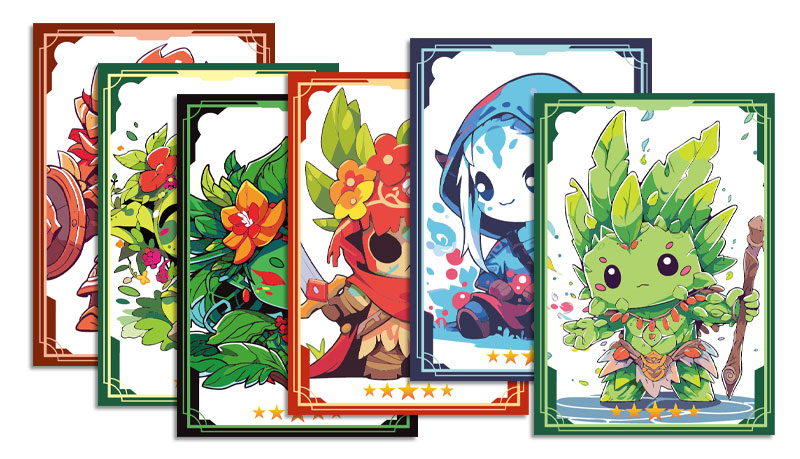
Next, design your cards
Easily said, right? But once you have chosen a theme, you’ll need to work on your theme to generate ideas for card styles, characters, powers, points systems and more. You can start just scribbling rough possibilities in a sketch pad or on your tablet. In the early stages, don’t worry too much about the results. This is free creative play to generate as many possibilities as you can. Once you’ve produced a good body of potential material, sift through it and look for the concepts which “grab you”. Chances are they’re the ones that will grab other people, too!
You’ll need to think about several elements that typically go into trading card composition. For example:
- The card’s name or title
- The central image or illustration
- Points, shields, powers, etc., for game cards
- Any relevant text
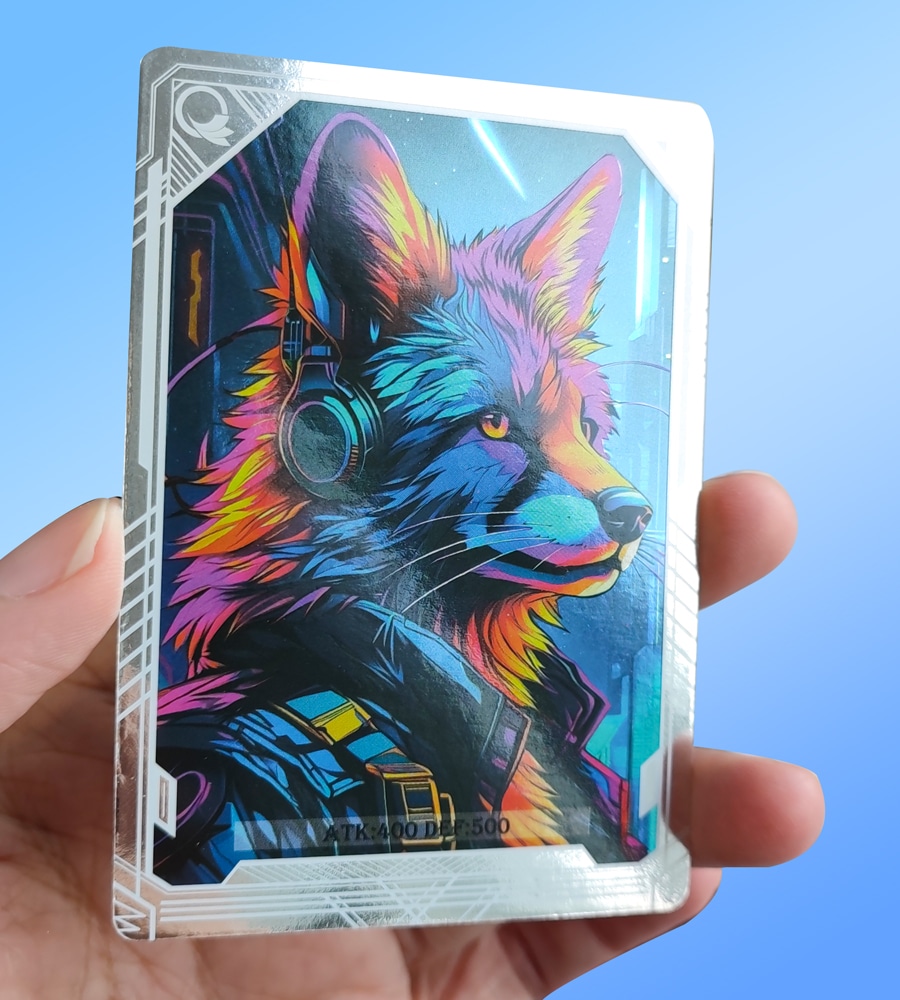
You should then decide on the number of cards you want to make up your deck. Here, there are no rules. The standard poker deck has 52 cards. A full Pokémon set has 59. You can get decks with as few as 10 cards. Magic: The Gathering now has over 27,000 magic cards in its circle! So, it’s really up to you. And if your deck is successful, you’ll almost certainly want to add booster packs, special cards, and more as you go.
So, once you’ve got your theme and used it to make a rough idea of the cards you want to design and the number of them, it’s time to turn to design software and start. You can either do this yourself if you’re familiar with suitable software—we recommend Adobe Illustrator although if you don’t want to or can’t pay the subscription, try a free online design tool like Canva—or you can hire a professional designer to realize your concept sketches for you. Unless you are a trained artist or graphic designer, if you can afford to outsource the artwork, this is always the best option. Either way, here are the key elements to consider during the design process:
• Card size and layout
Decide on the size and layout of your cards. Standard trading card sizes are 2.5 inches by 3.5 inches, but you can also choose other sizes depending on your preference. Think about whether you want a portrait or landscape orientation for your cards and how much information you want to include on each card. It’s a good idea to study as wide a range of successful trading packs as you can to get an idea of the parameters which work best.
• Card front design
The card front is the most important part of your trading cards, as it will feature the primary image or artwork. This will be developed from your rough sketches and it should obviously be an image, object, character, or personality that reflects the theme of your cards. You can use your own artwork, photographs, or even digital illustrations. Although if you go this route, make sure you’re not breaching copyright laws. If you’re creating your images in Illustrator, say, using vectors, that’s the ideal. But if you need to use photographers or work with raster images, then make sure they’re high resolution. Basically, that means at least 300 dpi.
• Card back design
The card back is where you can include your logo or branding to make your cards look professional. The backs of cards can either be “blank”—other than your logo and name—or patterned and illustrated. As a general rule, while each card front will be specific to that card, card backs are the same throughout the deck.
• Special finishes and effects
Trading cards can be so much more than just ink on paper. At QinPrinting, we can offer you a fantastic range of special effects and finishes from holographic card printing, hot metallic foil stamping, and lamination to UV spot coating and texturing. Consider adding additional elements to your custom trading cards to make them extra special. This could include borders, textures, patterns, or any of the special effects we’ve just mentioned. Experiment with distinct design elements to create a unique and eye-catching look for your cards.
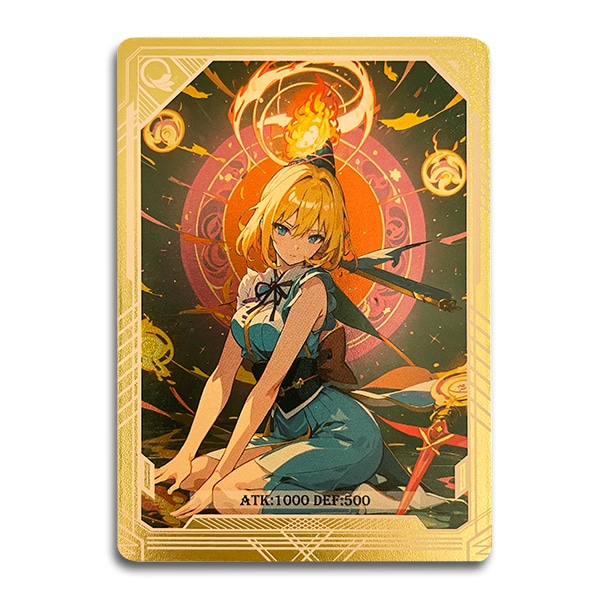
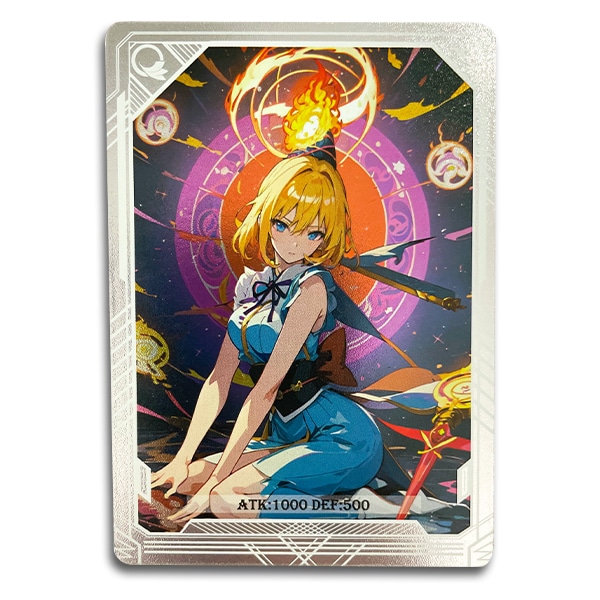
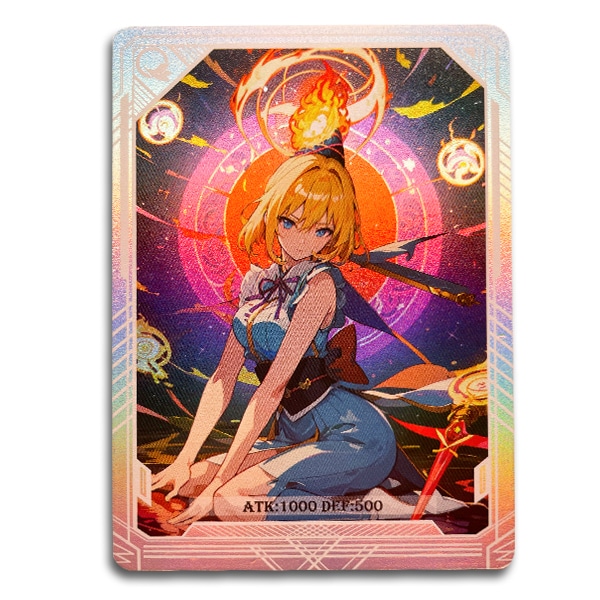
Printing your custom trading game cards
Once you’re satisfied with the design of your custom trading cards, it’s time to bring them to life by printing them. There are several printing options available to suit your needs and budget. But of them all, the most efficient, high-quality, and economical if you need to print over 200 decks, is offset printing. That’s what we specialize in here at QinPrinting. We also design, manufacture, and print packaging and boxes, so we can make a beautiful custom box to house your finished deck, too!
We have specialized equipment and expertise in printing high-resolution images on cardstock. We also offer custom sizes and finishes to meet your specific needs. If you are looking into how to design and print custom trading cards because you want to sell them, then offset printing is far and away the best option.
However, other options are available if you just need to print a few decks for your hobby or club and the quality doesn’t need to be perfect. Various print-on-demand services allow you to upload your card designs and have them printed as needed. This is a convenient option if you don’t want to print a large quantity of cards at once. Many print-on-demand services also offer options for different card sizes and finishes, although the range is more limited and the results are less reliable.
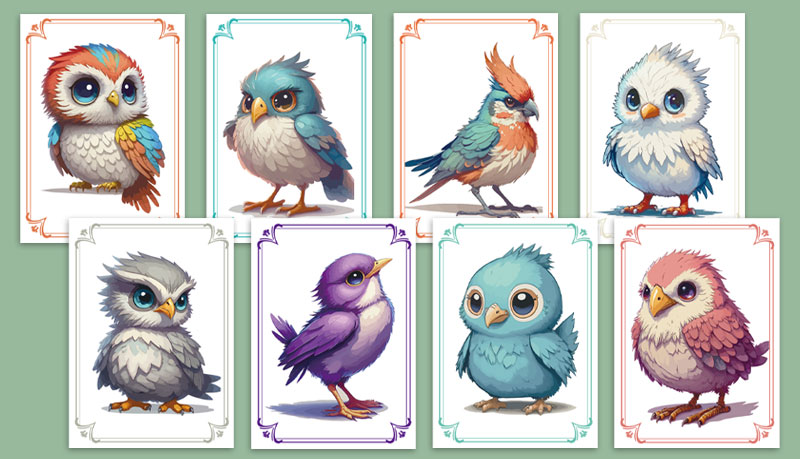
Protecting your cards
Once your custom trading cards are printed, it’s important to protect them from damage. We’ve already mentioned that we can design, build, and print custom boxes for you. But there are other possibilities to consider, too. Here are some options for protecting your cards and ensuring their longevity:
• Card sleeves
Card sleeves are a popular choice for protecting trading cards. These clear plastic sleeves fit over the cards and provide a layer of protection against scratches and dirt. Look for sleeves that are made specifically for the size of your custom trading cards. These sleeves are readily available from a variety of traders online and offline. But if you want us to source them for you, we will, and we may offer you a discount based on wholesale prices depending on how many you want. Just ask!
• Card toploaders
For extra protection, you can use card top loaders. These rigid plastic holders encase the entire trading card, preventing it from bending or getting damaged. Card top loaders are especially useful for more valuable or collectible cards that collectors or players want to preserve in mint condition. Again, if you order a large run, we may source these for you at reduced prices.
• Card presentation boxes
Of course, your core deck should come packaged in a beautiful presentation box. We specialize in this aspect of the industry as well as making the cards themselves. From structural design, to materials choices, to printing, closures, and special finishes, we can make anything from a basic box to a luxury fully customized solution. If this interests you, talk to us. You can contact us easily via telephone, email, Skype, the live chat (when we’re in the office!) or the contact form.
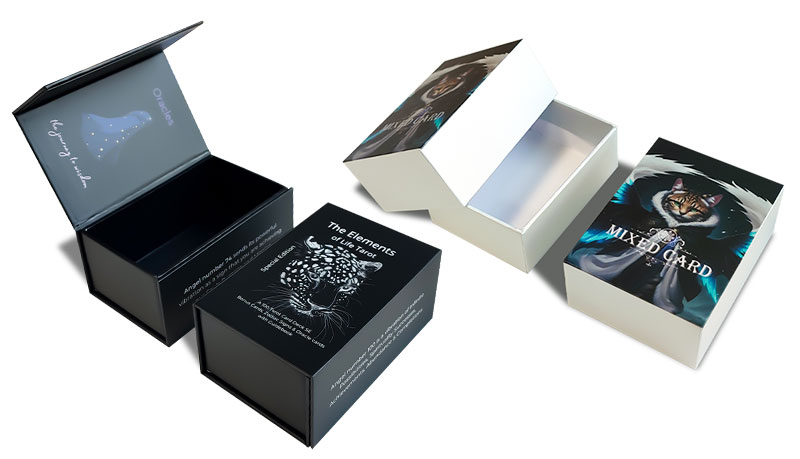
What materials do I need to make custom trading cards?
To make custom trading cards, the principal material is the card or paper from which the cards are made. We suggest the following options as the best and most reliable according to our long experience. But if you are in any doubt, just talk to us. We’ll be happy to listen with care to your needs and advise you based on what you’re aiming for and your budget.
- 310 gsm / 114 lb black core paper
- 300 gsm / 110 lb gloss or matte art paper
- 350 gsm / 129 lb gloss art paper
- two sheets of 250 gsm / 92 lb C1S paper or 300 gsm / 110 lb C1S paper or 350 gsm / 129 lb C1S paper glued together
To get a lot more detail about the materials and processes involved in how to design and print custom trading cards, read our key page, Game Card Printing.
How do I design the artwork for my custom trading cards?
Designing the artwork for your custom trading cards requires creativity and planning. If you’re not familiar with professional design software, then expect a learning curve. The alternative is to get a third-party designer to create the digital files for you based on your traditional hand-drawn artwork or digitally drawn art created on your tablet. But if you’re doing it yourself, here are some useful points to remember:
- Use professional software. We recommend Adobe Illustrator / InDesign / Photoshop
- Create your images using vectors whenever possible
- If you can’t use vectors — if you’re exporting bitmaps from Photoshop, for example — then make sure that you set the image resolution to at least 300 dpi
- Make sure that you change the color space from RGB to CMYK before you export
- If you have a design with colors or images which extend all the way to the edge of the finished cards, remember to add a 3 mm “bleed zone” to allow for die-cutting
- If you’re not exporting your artwork as vectors, you must separate the die-cutting design and the printable artwork into two layers
- Export your files in PDF format for printing
If you’re working with a professional designer to create your files, they should understand what’s needed to make everything “print ready”. But if you’re working with design software yourself for the first time, these are the vital tips to remember before you submit your files. Still, if you choose us to print your cards, our team of experts will always manually check all your files before we go to press. If we find any issues, we’ll let you know and help you resolve them.
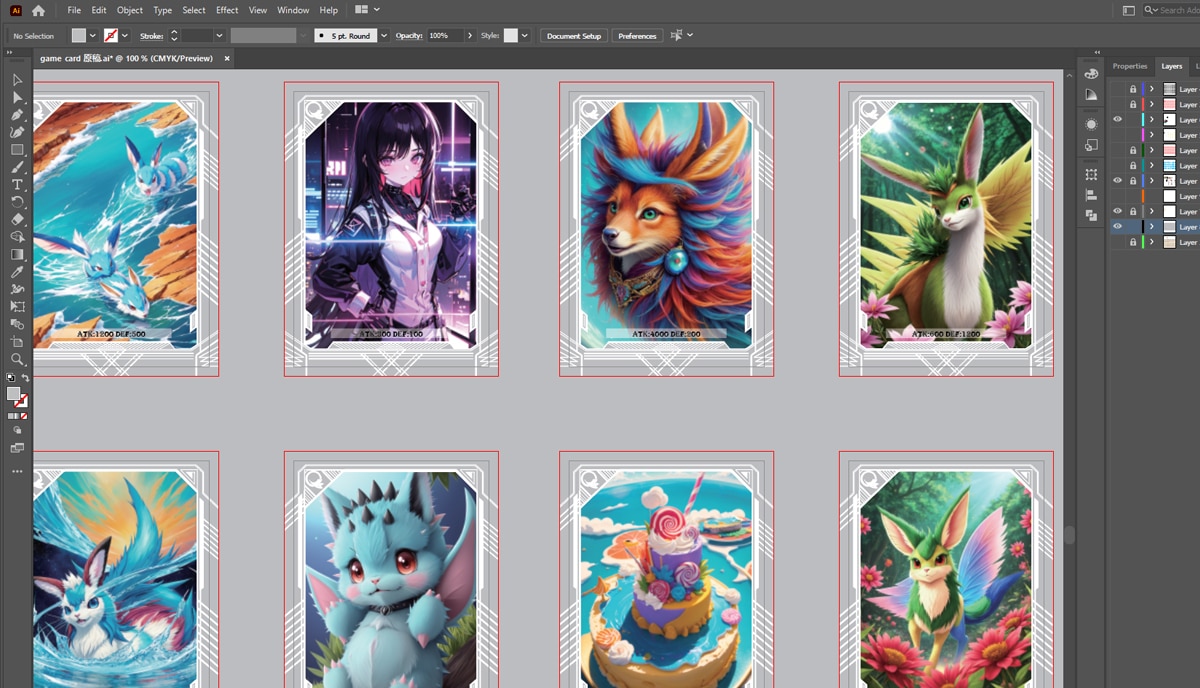
Can I sell my custom trading cards?
Yes, you can sell your custom trading cards. If you include a booklet in your box and add an ISBN, your card deck also counts as a book and you can sell it into the booksellers’ catalogs. Many bookstores also stock games. Here are a few other options for selling them:
- Online marketplaces: List your custom trading cards on popular online marketplaces like Amazon, eBay or Etsy.
- Local events and conventions: Look for local events or conventions that cater to trading card enthusiasts and rent a booth or table to showcase and sell your cards.
- Social media platforms: Use social media platforms like Instagram, Twitter, or Facebook to promote and sell your custom trading cards.
Before selling your cards, research the market to determine appropriate pricing and make sure you comply with any legal and safety requirements in your country.
Creating custom trading cards to sell or as a hobby is a fun and creative process that allows you to showcase your own unique designs and ideas and share them with the world. Whether you’re a fan, an artist, an independent creative entrepreneur, or simply enjoy taking part in the card collecting community, making custom trading cards can be a rewarding experience. Remember to put your creativity to work during the design phase, choose a high-quality printing method, and protect your cards with a custom-built box.
How to print your card game
If you need only a handful of copies of your trading cards for fun alone or to share with a small group of friends, digital printing may be your best option. But if you have a commercial reason for finding out how to design and print custom trading cards — namely, you mean to sell them! — and you need 200+ decks, a smart booklet insert, and a custom printed box to package it all in, then offset printing is the cheaper option and offers far-and-away the best quality.
Talk to us. We're here to help!
At QinPrinting we’ve been making custom trading card decks, accessories, and stunning printed boxes for decades. We work with businesses and independent creatives alike. Chat to us today to discuss your ideas. One of our expert printers with experience in card design and manufacture will be happy to help and advise you. Or if you’re further along in the process and you have files ready to go to press, we’ll be delighted to give you an unbeatable, no-obligation quote. Let’s talk! Just give us a call on +86 21 6538 1716 (bearing in mind potential time zone differences) or shoot us an email to [email protected] and we’ll be delighted to help you.





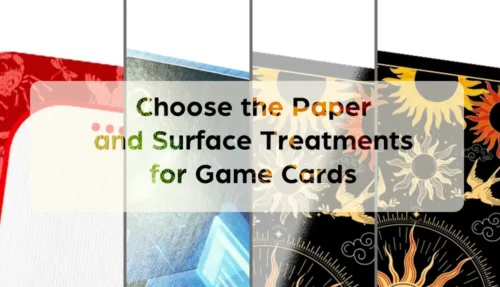
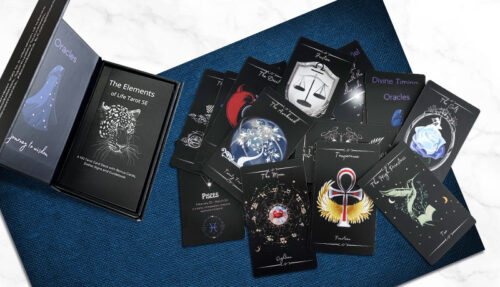
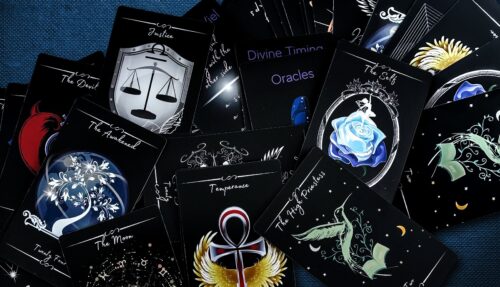
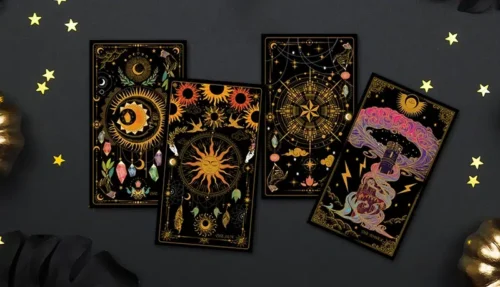
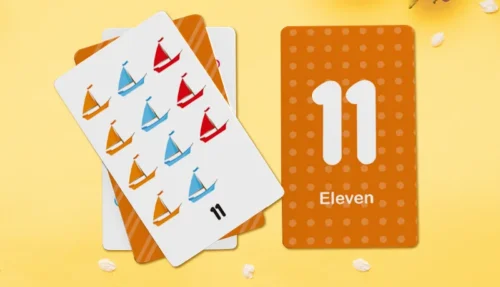
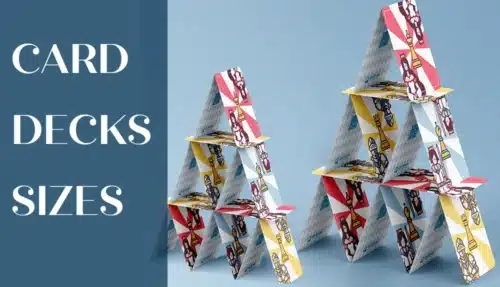
2 thoughts on “How to Design and Print Custom Trading Cards”
this is great blog and very helpful.
Thank you for information.
I have one guestion that which printing devices we need for production the higj quality collectables cards
Hi Umid. As an offset printing company, we specialize in providing printing services rather than selling printing machines. For producing high-quality collectible cards, we recommend you to consider contacting professional printing equipment suppliers. They can assist you in selecting the right printing equipment. But the best thing may be to let us print them for you! If that option might interest you, shoot us an email at [email protected] and we'd be happy to discuss how we can help.